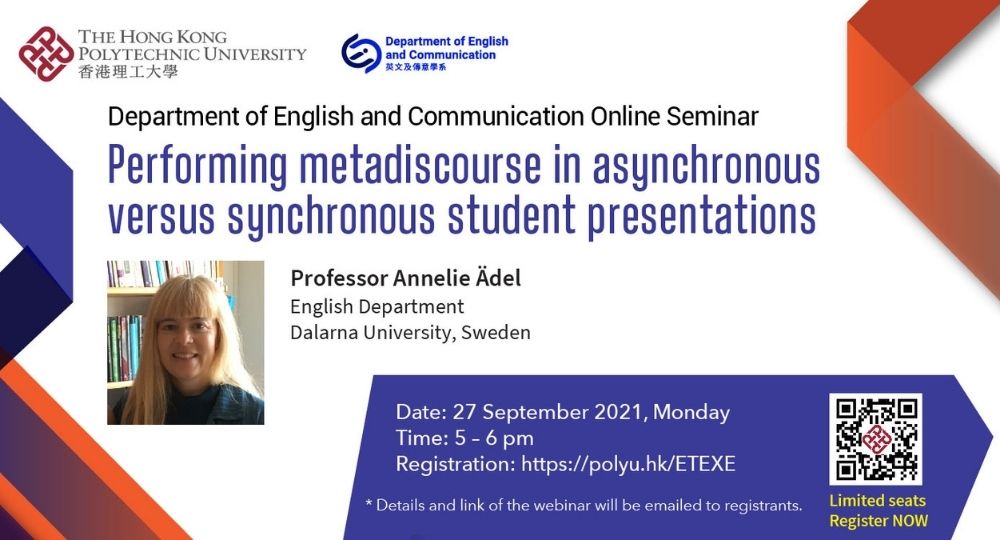Seminar l Performing metadiscourse in asynchronous versus synchronous student presentations
Seminars / Lectures / Workshops

-
Date
27 Sep 2021
-
Organiser
Department of English and Communication
-
Time
17:00 - 18:00
-
Venue
Zoom
Speaker
Prof. Annelie Ädel
Summary
In this talk, a reflexive approach to metadiscourse (Ädel & Mauranen, 2010) is adopted. This means seeing metadiscourse as “reflexive linguistic expressions referring to the evolving discourse itself or its linguistic form, including references to the writer-speaker qua writer-speaker and the (imagined or actual) audience qua audience of the current discourse” (Ädel 2010, p. 75). The focus of the talk will be on qualitative findings and especially a taxonomy of metadiscursive functions that resulted from the main research question “How is metadiscourse used in student presentations?”. While prevailing taxonomies of metadiscourse tend to involve rather fragmentary, often word-based, units, the aim of this study is to provide a more function-based and contextualised analysis of the types of discourse acts that speakers/writers use metadiscourse to perform (e.g. INTRODUCING TOPIC; REFORMULATING; ACKNOWLEDGING THE AUDIENCE).
The functional taxonomy will be illustrated with examples from the material, which consists of oral presentations, with visual support, from an English-language net-based teaching context and, more specifically, an MA programme in Applied Linguistics. The student presenters summarise and critique published research articles. Approximately half of the material involves asynchronous presentations—students’ digital recordings for fellow students to watch before class—and the other half synchronous presentations—where students present live in class. The material is based on a total of 13 student presentations, amounting to just over 20,000 words, representing 169 minutes of presentation time (on average, 10.5 minutes per presentation).
Some quantitative results will also be presented, based on the second research question “To what extent are there differences in the use of metadiscourse that can be associated with the two communicative contexts (synchronous versus asynchronous)?”. The main finding is that there is more of everything in the synchronous data. The synchronous presenters orient more frequently to the audience and they refer more frequently to visuals. They also refer to linked genres considerably more often than in the synchronous data, which indicates a greater awareness of the connections between their presentation and the course or MA programme as a whole. Previous research has shown that the choice of genre may have an effect on the use of metadiscourse. What the present study indicates is that, even within a genre, contextual factors in how the genre is presented may also affect the use of metadiscourse, in terms of both frequency and types of discourse functions that are drawn on.
Keynote Speaker
Annelie Ädel's main research areas are discourse analysis and pragmatics, corpus linguistics, English for Specific Purposes and English as a Second Language. She has been affiliated with the University of Michigan's English Language Institute as director of Applied Corpus Linguistics and with Stockholm University as a research fellow. She is currently professor of English Linguistics at Dalarna University, Sweden.



